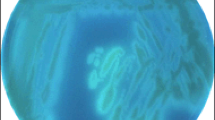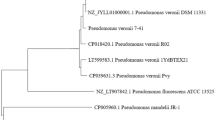Abstract
Pseudomonas aeruginosa IBBML1, isolated from Poeni petroleum sludge, was able to tolerate and degrade both saturated (n-hexane, n-heptane, n-hexadecane, cyclohexane) and aromatic (benzene, ethylbenzene, propylbenzene, xylene isomers, styrene) hydrocarbons. Molecular studies have revealed that the high hydrocarbon resistance of Pseudomonas aeruginosa IBBML1 could be due to the action of members of the HAE1 (hydrophobe/amphiphile efflux 1) family of transporters. It is further possible that additional mechanisms may account for the tolerance of Pseudomonas aeruginosa IBBML1 to hydrocarbons, and a combination of short-term and long-term mechanisms may act together in the adaptation of Pseudomonas aeruginosa IBBML1 cells to saturated and aromatic hydrocarbons. β-galactosidase activity measurements revealed that there was significant induction of the lacZ gene in Pseudomonas aeruginosa IBBML1 cells grown in the presence of either 5% and 10% (v/v) saturated or aromatic hydrocarbons, compared with control (cells incubated without hydrocarbons). Rhodamine 6G accumulation in Pseudomonas aeruginosa IBBML1 cells grown in the presence of 5% and 10% (v/v) saturated hydrocarbons was higher than rhodamine 6G accumulation in cells grown in the presence of 5% and 10% (v/v) aromatic hydrocarbons. The study of cellular and molecular modifications to Pseudomonas aeruginosa IBBML1 induced by 5% and 10% (v/v) saturated and aromatic hydrocarbons revealed a complex response of bacterial cells to the presence of different hydrophobic substrates in the culture medium.
Similar content being viewed by others
References
Samanta S.K., Singh O.V., Jain R.K., Polycyclic aromatic hydrocarbons: environmental pollution and bioremediation, Trends Biotechnol., 2002, 20, 243–248
Okoh A.I., Biodegradation alternative in the cleanup of petroleum hydrocarbon pollutants, Biotechnol. Mol. Biol. Rev., 2006, 1, 38–50
Wrenn B., Venosa A.D., Selective enumeration of aromatic and aliphatic hydrocarbon degrading bacteria by a most probable number procedure, Can. J. Microbiol., 1996, 42, 252–259
Mendoza R.E., Hydrocarbon leaching, microbial population, and plant growth in soil amended with petroleum, Biorem. J., 1998, 3, 223–231
Andreoni V., Cavalca L., Rao M.A., Nocerino G., Bernasconi S., DellÁmico E., et al., Bacterial communities and enzyme activities of PAHs polluted soils, Chemosphere, 2004, 57, 401–412
Obbard J.P., Ng K.L., Xu R., Biorremediation of petroleum contaminated beach sediments: use of crude palm oil and fatty acids to enhance indigenous biodegradation, Water Air Soil Pollut., 2004, 157, 149–161
Labud V., Garcia C., Hernandez T., Effect of hydrocarbon pollution on the microbial properties of a sandy and a clay soil, Chemosphere, 2007, 66, 1863–1874
Rodriguez-Herva J.J., Ramos-Gonzalez M.I., Ramos J.L., The Pseudomonas putida peptidoglycanassociated outer membrane lipoprotein is involved in maintenance of the integrity of the cell envelope, J. Bacteriol., 1996, 178, 1699–1706
Inoue A., Horikoshi K., A Pseudomonas thrives in high concentrations of toluene, Nature, 1989, 338, 264–266
Ramos J.L., Duque E., Huertas M.J., HaÍdour A., Isolation and expansion of the catabolic potential of a Pseudomonas putida strain able to grow in the presence of high concentrations of aromatic hydrocarbons, J. Bacteriol., 1995, 177, 3911–3916
Ramos J.L., Duque E., Rodriguez-Hervas J.J., Godoy P., Haidour A., Reyes F., et al., Metabolism for solvent tolerance in bacteria, J. Biol. Chem., 1997, 272, 3887–3890
Ramos J.L., Duque E., Godoy P., Segura A., Efflux pumps involved in toluene tolerance in Pseudomonas putida DOT-T1E, J. Bacteriol., 1998, 180, 3323–3329
Ramos J.L., Duque E., Gallegos M.T., Godoy P., Ramos-Gonzalez M.I., Rojas A., et al., Mechanisms of solvent tolerance in Gram-negative bacteria, Annu. Rev. Microbiol., 2002, 56, 743–768
Ramos-González M.-I., Godoy P., Alaminos M., Ben-Bassat A., Ramos J.L., Physiological characterization of Pseudomonas putida DOT-T1E tolerance to p-hydroxybenzoate, Appl. Environ. Microbiol., 2001, 67, 4338–4341
Segura A., Duque E., Mosqueda G., Ramos J.L., Junker F., Multiple responses of Gram-negative bacteria to organic solvents, Environ. Microbiol., 1999, 1, 191–198
Segura A., Godoy P., van Dillewijn P., Hurtado A., Arroyo N., Santacruz S., et al., Proteomic analysis reveals the participation of energy- and stressrelated proteins in the response of Pseudomonas putida DOT-T1E to toluene, J. Bacteriol., 2005, 187, 5937–5945
Segura A., Hurtado A., Rivera B., Lăzăroaie M.M., Isolation of new toluene-tolerant marine strains of bacteria and characterization of their solventtolerance properties, J. Appl. Microbiol., 2008, 104, 1408–1416
Isken S., de Bont J.A.M., Bacteria tolerant to organic solvents, Extremophiles, 1998, 2, 229–238
Osborne S.J., Leaver J., Turner M.K., Dunnill P., Correlation of biocatalytic activity in an organicaqueous two-liquid phase system with solvent concentration in the cell membrane, Enzyme Microb. Technol., 1990, 12, 281–291
Sikkema J., de Bont J.A.M., Poolman B., Mechanisms of membrane toxicity of hydrocarbons, Microbiol. Rev., 1995, 59, 201–222
Heipieper H.J., Weber F.J., Sikkema J., Keweloh H., de Bont J.A.M., Mechanisms of resistance of whole cells to toxic organic solvents, Trends Biotechnol., 1994, 12, 409–414
Weber F.J., de Bont J.A.M., Adaptation mechanisms of microorganisms to the toxic effects of organic solvents on membranes, Biochim. Biophys. Acta, 1996, 1286, 225–245
Heipieper H.J., Neumann G., Cornelissen S., Meinhardt F., Solvent-tolerant bacteria for biotransformations in two-phase fermentation systems, Appl. Microbiol. Biotechnol., 2007, 74, 961–973
Lăzăroaie M.M., Pseudomonas aeruginosa IBBML1 adaptation to high concentrations of hydrocarbons, Electronic Journal of Biology, 2008, 4, 17–26, http://www.ejbio.com/pps/2008/17.pdf
De Ley J., The quick approximation of DNA base composition from absorbancy ratios, Antonie van Leeuwenhoek, 1976, 33, 203–208
Grifoll M., Selifonov S.A., Gatlin C.V., Chapman P.J., Actions of a versatile fluorene-degrading bacterial isolate on polycyclic aromatic hydrocarbons, Appl. Environ. Microbiol., 1995, 61, 3711–3723
Nielsen L.E., Kadavy D.R., Rajagopal S., Drijber R., Nickerson K.W., Survey of extreme solvent tolerance in gram-positive cocci: membrane fatty acid changes in Staphylococcus haemolyticus grown in toluene, Appl. Environ. Microbiol., 2005, 71, 5171–5176
Sambrook J., Fritsch E.F., Maniatis T., Molecular cloning - a laboratory manual, 2nd ed., Cold Spring Harbor Laboratory Press, Cold Spring Harbor, New York, 1989
Miller J.H., Assay of β-galactosidase, In: Experiments in Molecular Genetics, Cold Spring Harbor Laboratory Press, Cold Spring Harbor, New York, 1972
Rosenberg M., Gutnick D., Rosenberg E., Adherence of bacteria to hydrocarbons: a simple method for measuring cell-surface hydrophobicity, FEMS Microbiol. Lett., 1980, 9, 29–33
Benning C., Somerville C.R., Isolation and genetic complementation of a sulfolipid-deficient mutant of Rhodobacter sphaeroides, J. Bacteriol., 1992, 174, 2352–2360
Foght J.M., Fedorak P.M., Westlake W.S., Mineralization of [14C]-hexadecane and [14C]-phenanthrene in crude oil: specificity among bacterial isolates, Can. J. Microbiol., 1990, 36, 169–175
Sotsky J.B., Greer C.W., Atlas R.M., Frequency of genes in aromatic and aliphatic hydrocarbon biodegradation pathways within bacterial populations from Alaskan sediments, Can. J. Microbiol., 1994, 40, 981–985
Tseng T.T., Gratwick K.S., Kollman J., Park D., Nies D.H., Goffeau A., et al., The RND permease superfamily: an ancient, ubiquitous and diverse family that includes human disease and development proteins, J. Mol. Microbiol. Biotechnol., 1999, 1, 107–125
Zgurskaya H. I., Nikaido H., Multidrug resistance mechanisms: drug efflux across two membranes, Mol. Microbiol., 2000, 37, 219–225
Poole K., Multidrug resistance in gram-negative bacteria, Curr. Opin. Microbiol., 2001, 4, 500–508
Hearn E.M., Dennis J.J., Gray M.R., Foght J.M., Identification and characterization of the emhABC efflux system for polycyclic aromatic hydrocarbons in Pseudomonas fluorescens cLP6a, J. Bacteriol., 2003, 185, 6233–6240
Meguro N., Kodama Y., Gallegos M.T., Watanabe K., Molecular characterization of resistancenodulation-division transporters from solvent- and drug-resistant bacteria in petroleum-contaminated soil, Appl. Environ. Microbiol., 2005, 71, 580–586
Tokunaga H., Mitsuo K., Ichinose S., Omori A., Ventosa A., Nakae T., et al., Salt-inducible multidrug efflux pump protein in the moderately halophilic bacterium Chromohalobacter sp., Appl. Environ. Microbiol., 2004, 70, 4424–4431
Kieboom J., Dennis J.J., Zylstra G.J., Bont J.A.M., Active efflux of organic solvents in Pseudomonas putida S12 is induced by solvents, J. Bacteriol., 1998, 180, 6769–6772
Master E.R., Mohn W.W., Induction of bphA, encoding biphenyl dioxygenase, in two polychlorinated biphenyl-degrading bacteria, psychrotolerant Pseudomonas strain Cam-1 and mesophilic Burkholderia strain LB400, Appl. Environ. Microbiol., 2001, 67, 2669–2676
Ahmed M., Borsch C.M., Neyfakh A.A., Schuldiner S., Mutants of the Bacillus subtilis multidrug transporter Bmr with altered sensitivity to the antihypertensive alkaloid reserpine, J. Biol. Chem., 1993, 268, 11086–11089
Ahmed M., Borsch C.M., Taylor S.S., Vázquez-Laslop N., Neyfakh A.A., A protein that activates expression of a multidrug efflux transporter upon binding the transporter substrates, J. Biol. Chem., 1994, 269, 28506–28513
Ahmed M., Lyass L., Markham P.N., Taylor S.S., Vázquez-Laslop N., Neyfakh A.A., Two highly similar multidrug transporters of Bacillus subtilis whose expression is differentially regulated, J. Bacteriol., 1995, 177, 3904–3910
Poole K., Krebes K., McNally C., Neshat S., Multiple antibiotic resistance in Pseudomonas aeruginosa: evidence for involvement of an efflux operon, J. Bacteriol., 1993, 175, 7363–7372
Lewis K., Multidrug-resistance pumps in bacteria: variations on a theme, Trends. Biochem. Sci., 1994, 19, 119–123
Nikaido H., Prevention of drug access to bacterial targets: permeability barriers and active efflux, Science, 1994, 264, 382–388
Borges-Walmsley M.I., McKeegan K.S., Walmsley A.R., Structure and function of efflux pumps that confer resistance to drugs, Biochem. J., 2003, 376, 313–338
Nishino K., Yamaguchi A., Role of histone-like protein H-NS in multidrug resistance of Escherichia coli, J. Bacteriol., 2004, 186, 1423–1429
Vermuë M., Sikkema J., Verheul A., Bakker R., Tramper J., Toxicity of homologous series of organic solvents for the Gram-positive bacteria Arthrobacter and Nocardia sp. and Gram-negative bacteria Acinetobacter and Pseudomonas sp., Biotechnol. Bioeng., 1993, 42, 747–758
Neumann G., Kabelitz N., Zehnsdorf A., Miltner A., Lippold H., Meyer D., et al., Prediction of the adaptability of Pseudomonas putida DOT-T1E to a second phase of a solvent for economically sound two-phase biotransformations, Appl. Environ. Microbiol., 2005, 71, 6606–6612
Aono R., Kobayashi H., Cell surface properties of organic solvent tolerant mutants of Escherichia coli K-12, Appl. Environ. Microbiol., 1997, 63, 3637–3642
de Bont J.A.M., Solvent-tolerant bacteria in biocatalysis, Trends. Biotechnol., 1998, 16, 493–499
de Carvalho C.C.C.R., Wick L.Y., Heipieper H.J., Cell wall adaptations of planktonic and biofilm Rhodococcus erythropolis cells to growth on C5 to C16 n-alkane hydrocarbons, Appl. Microbiol. Biotechnol., 2009, 82, 311–320
Pinkart H.C., White D.C., Phospholipid biosynthesis and solvent tolerance in Pseudomonas putida strains, J. Bacteriol., 1997, 179, 4219–4226
Pinkart H.C., Wolfram J.W., Rodgers R., White D.C., Cell envelope changes in solvent-tolerant and solvent-sensitive Pseudomonas putida strains following exposure to o-xylene, Appl. Environ. Microbiol., 1996, 62, 1129–1132
van Hamme J.D., Singh A., Ward O.P., Recent advances in petroleum microbiology, Microbiol. Mol. Biol. Rev., 2003, 67, 503–549
McLellan T., Ames G.F.-L., Nikaido K., Genetic variation in proteins: comparison of onedimensional and two-dimensional gel electrophoresis, Genetics, 1983, 104, 381–390
Keweloh H., Weyrauch G., Rehm H.J., Phenolinduced membrane changes in free and immobilized Escherichia coli, Appl. Microbiol. Biotechnol., 1990, 33, 66–71
Author information
Authors and Affiliations
Corresponding author
About this article
Cite this article
Lăzăroaie, M.M. Investigation of saturated and aromatic hydrocarbon resistance mechanisms in Pseudomonas aeruginosa IBBML1 . cent.eur.j.biol. 4, 469–481 (2009). https://doi.org/10.2478/s11535-009-0050-0
Received:
Accepted:
Published:
Issue Date:
DOI: https://doi.org/10.2478/s11535-009-0050-0




